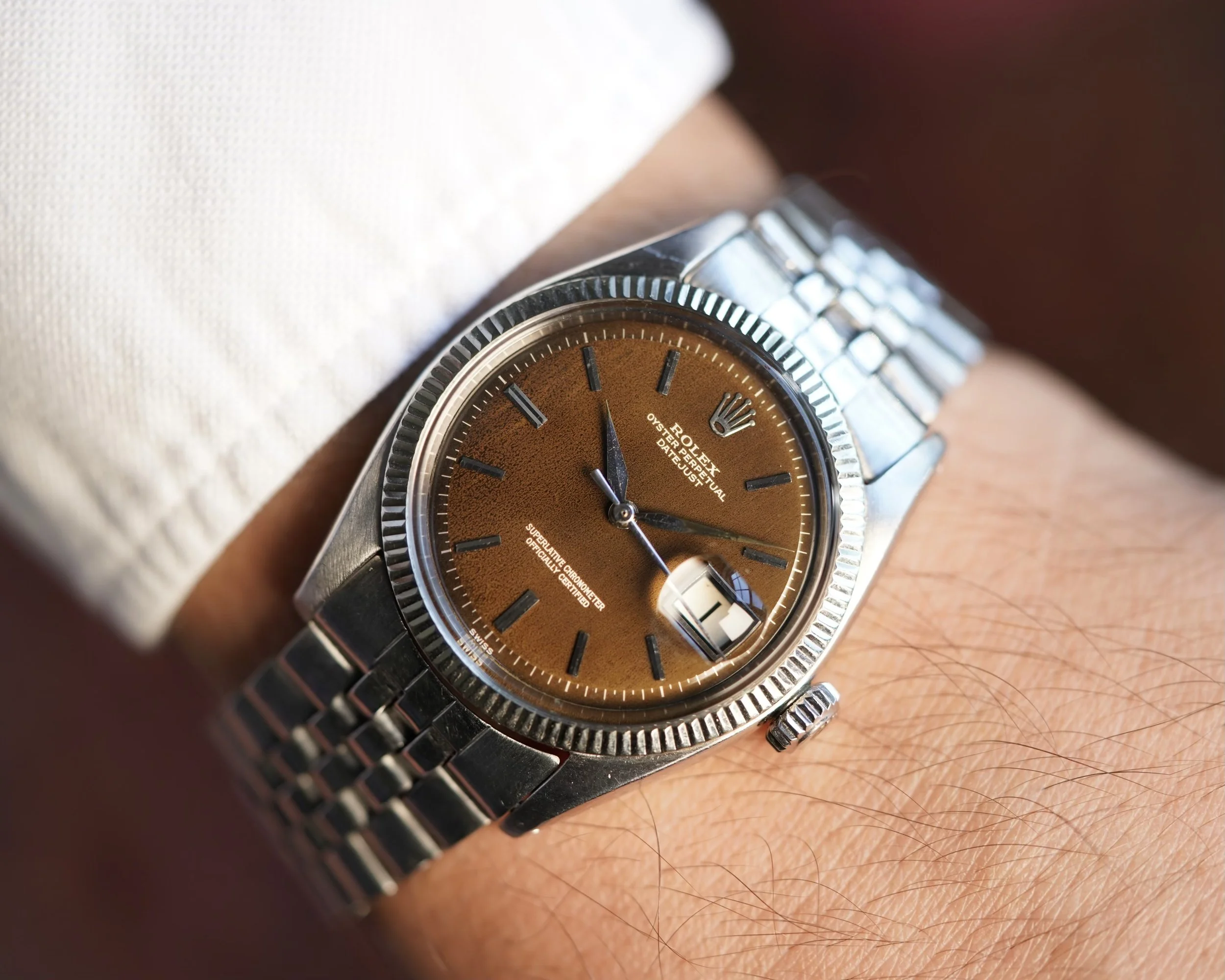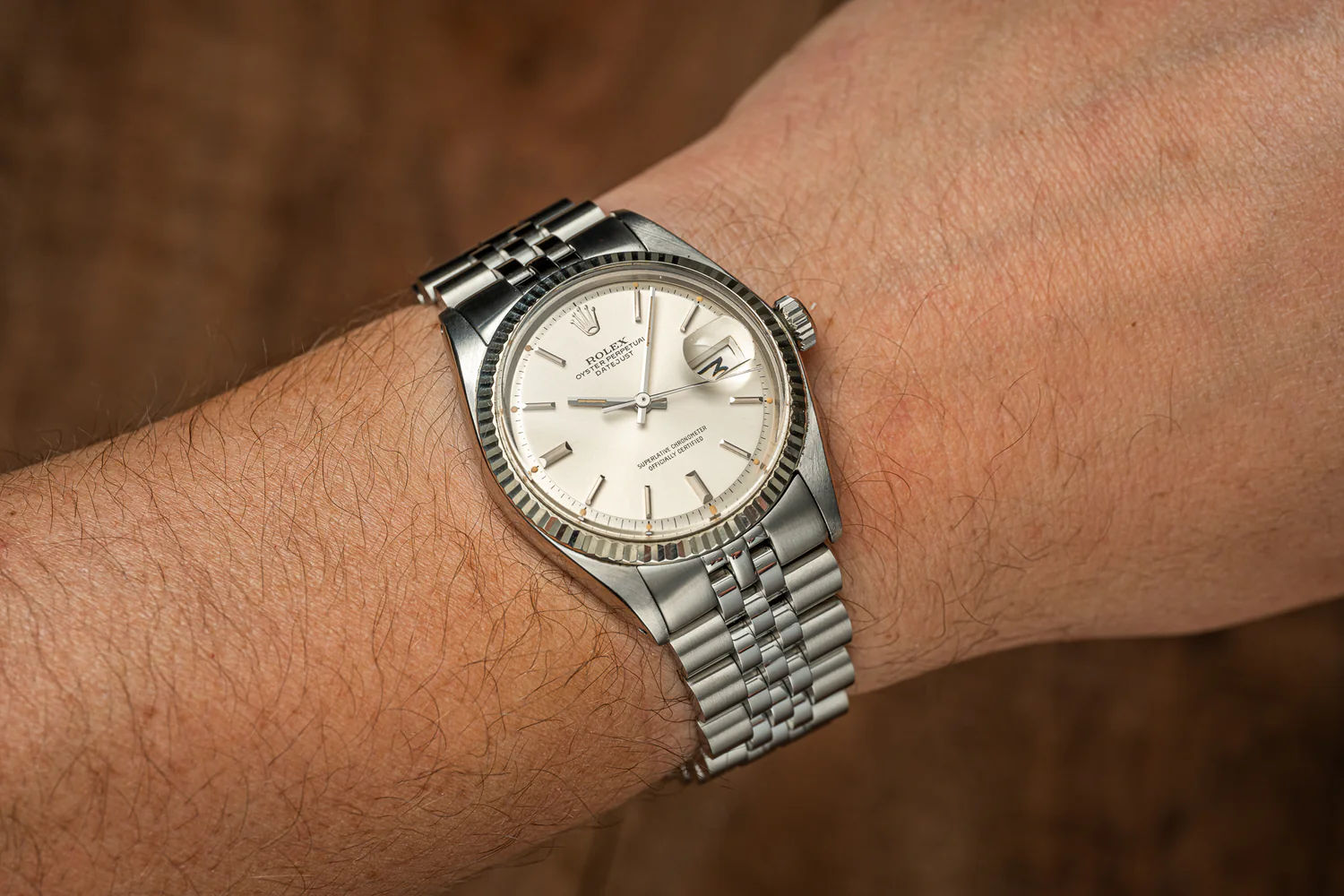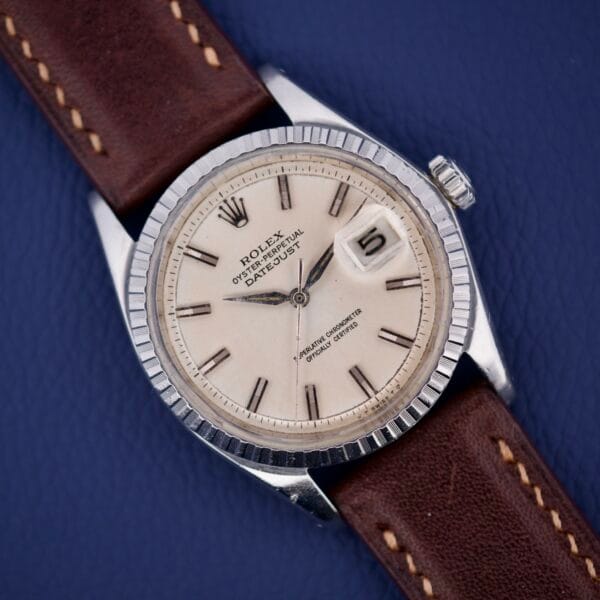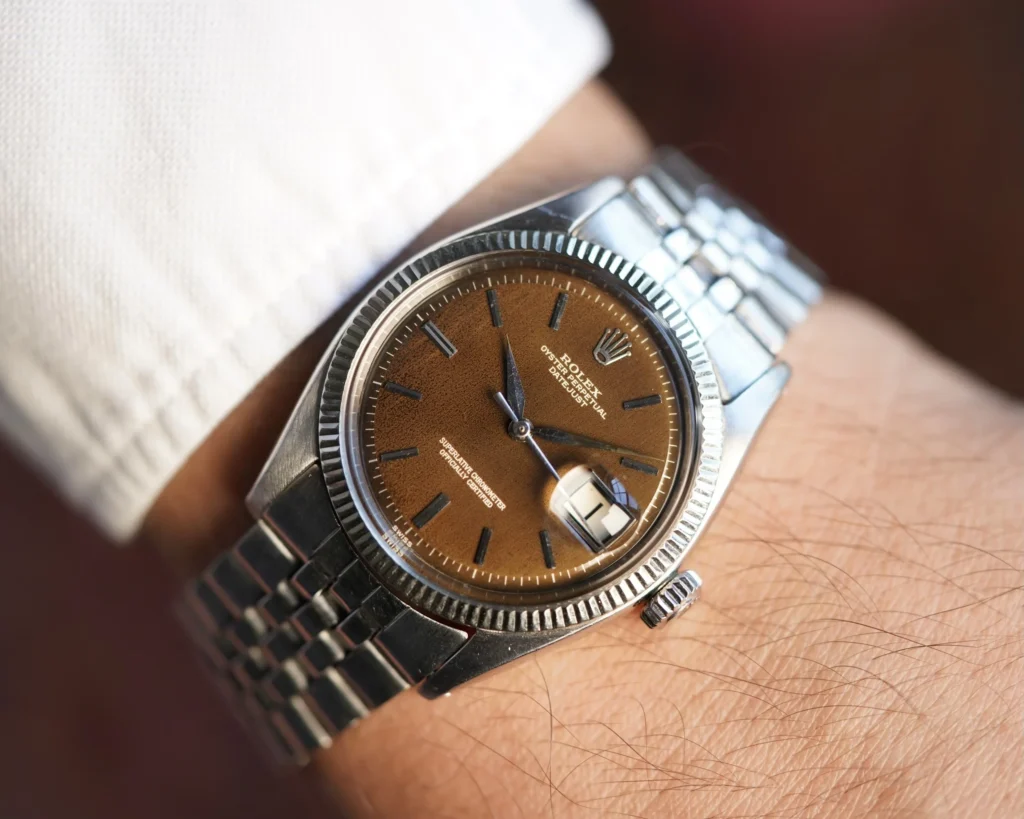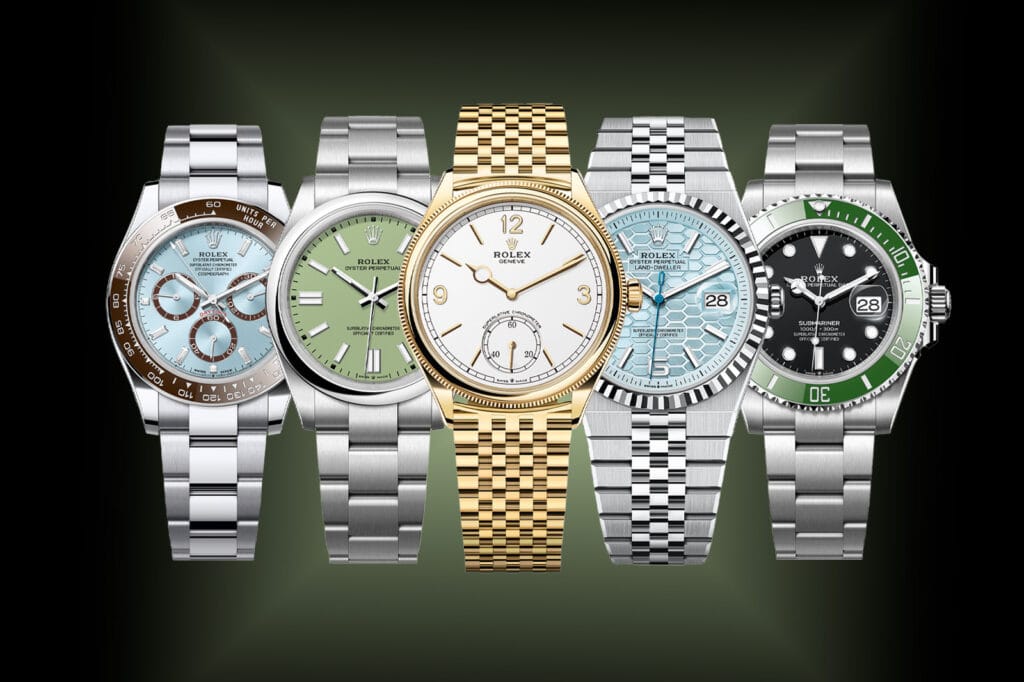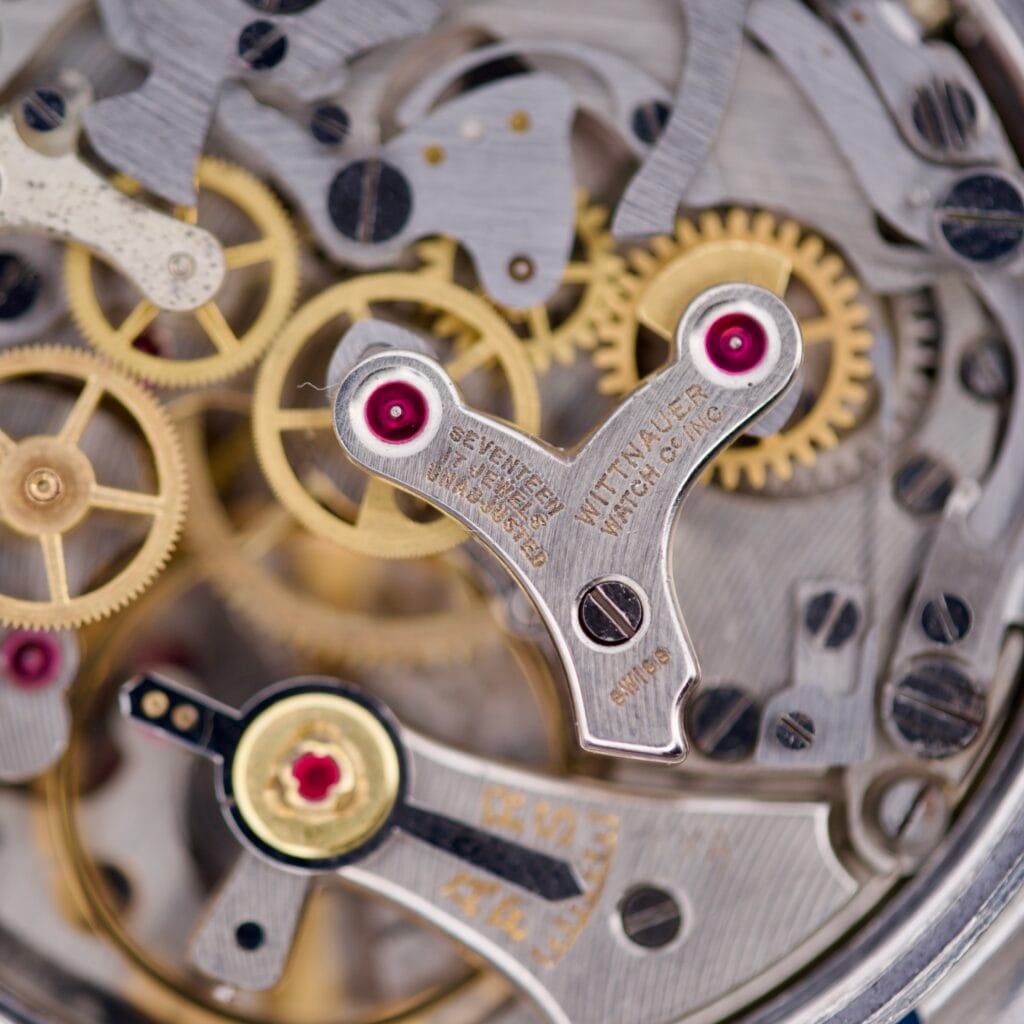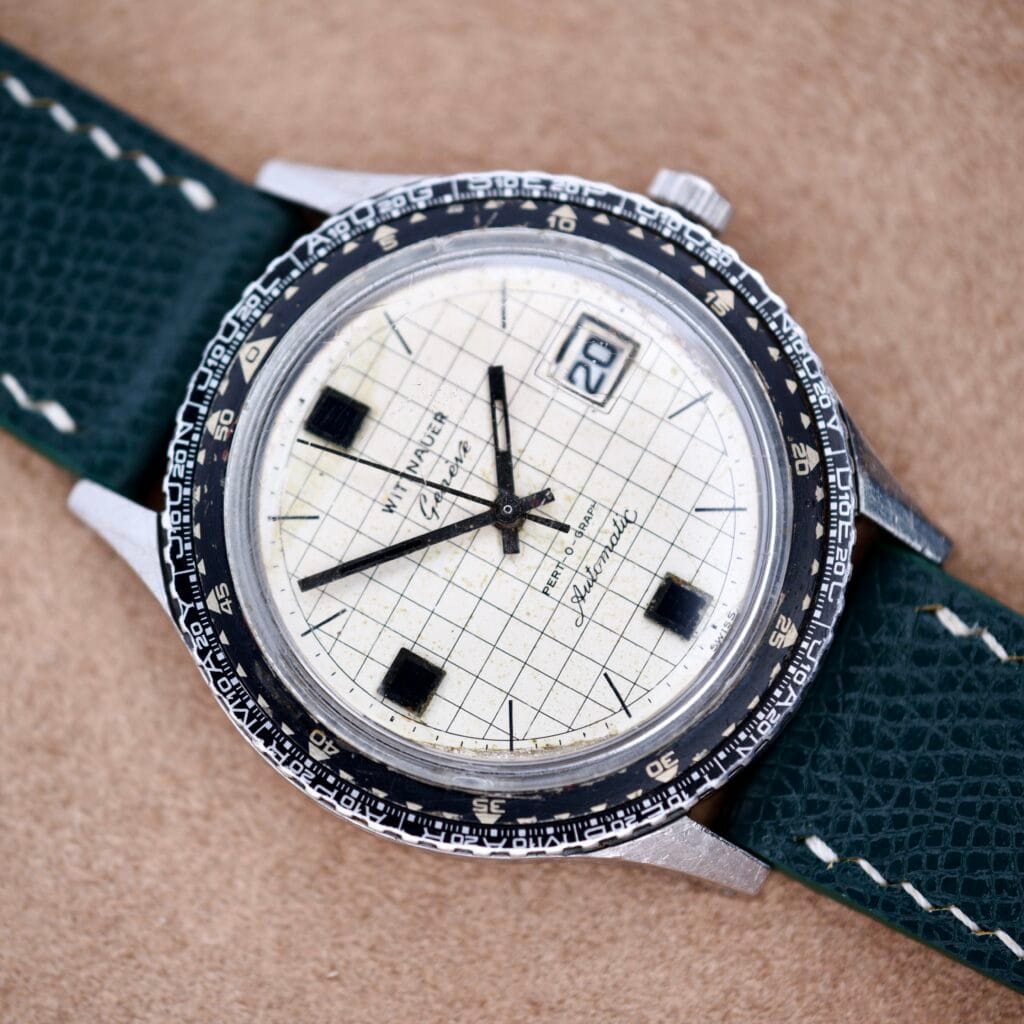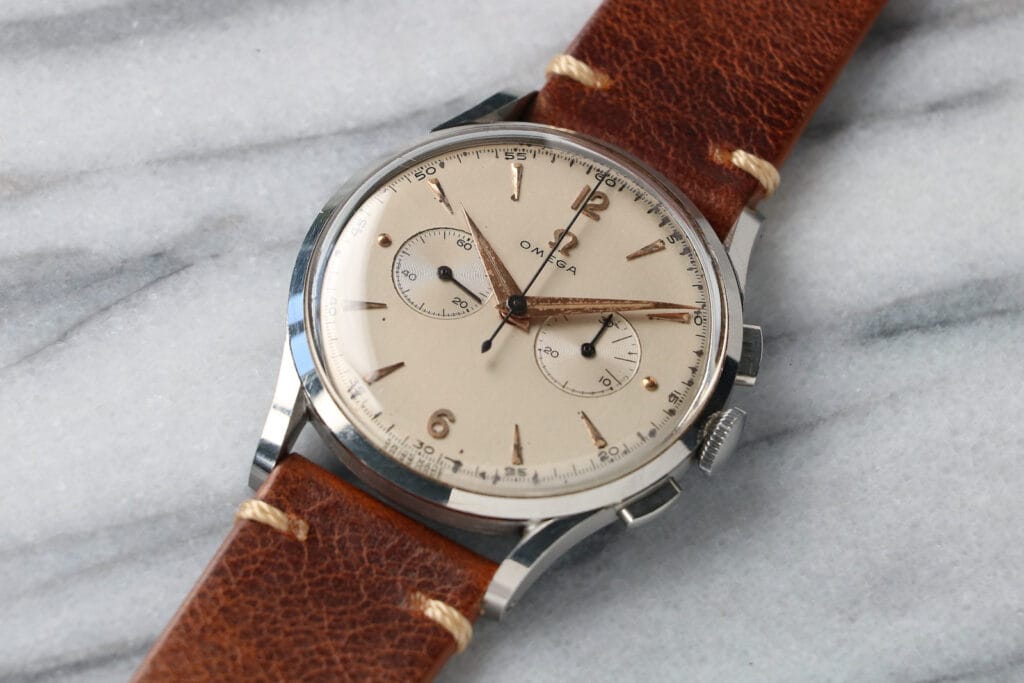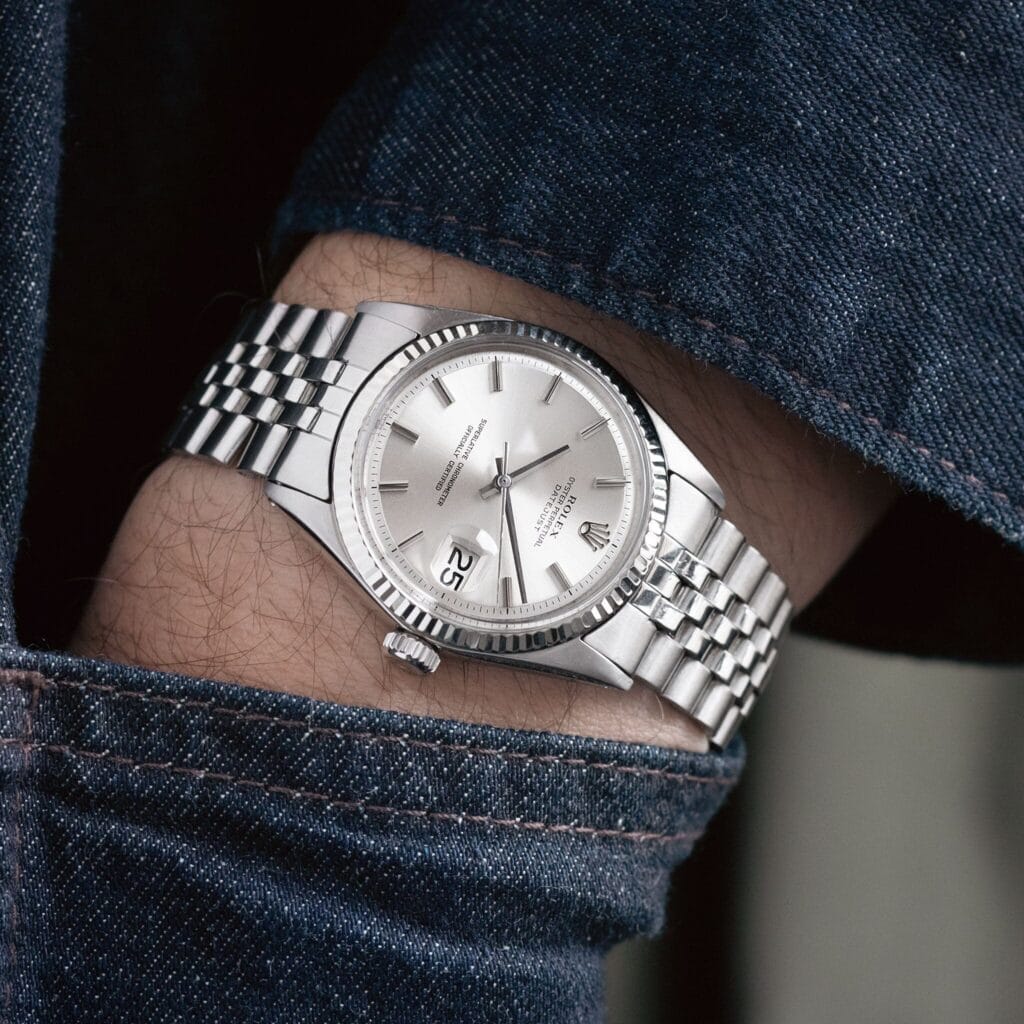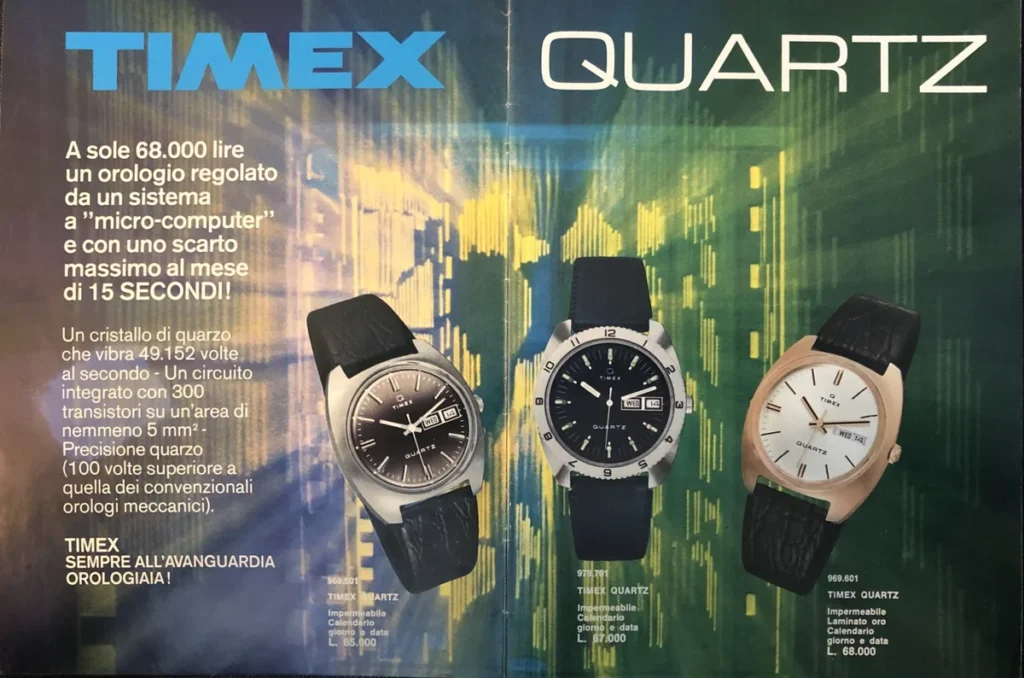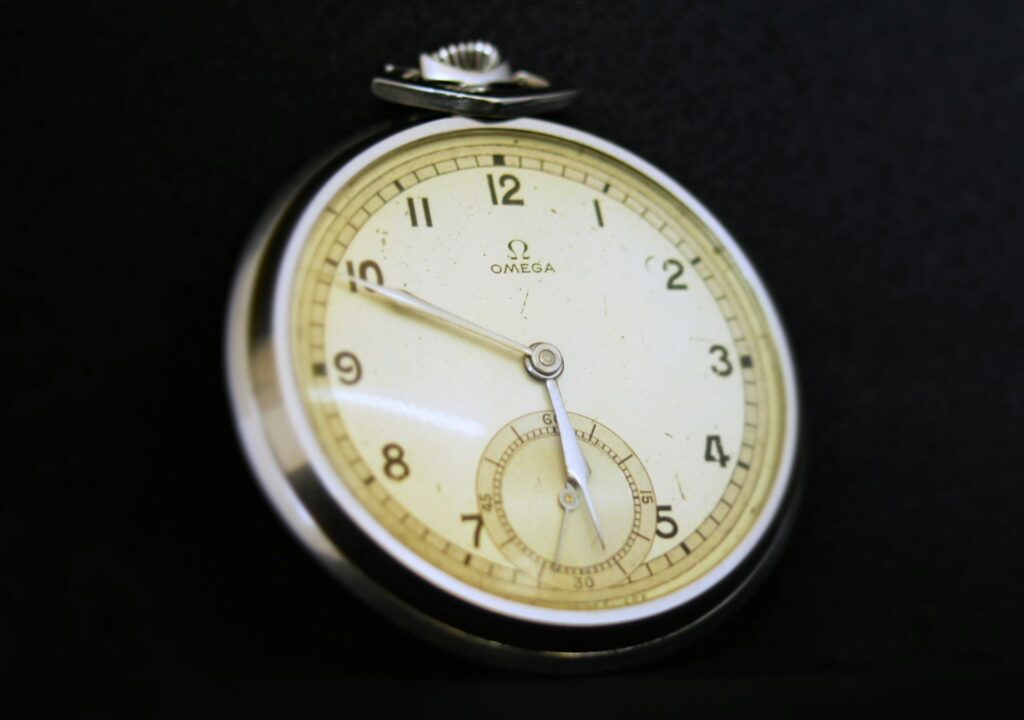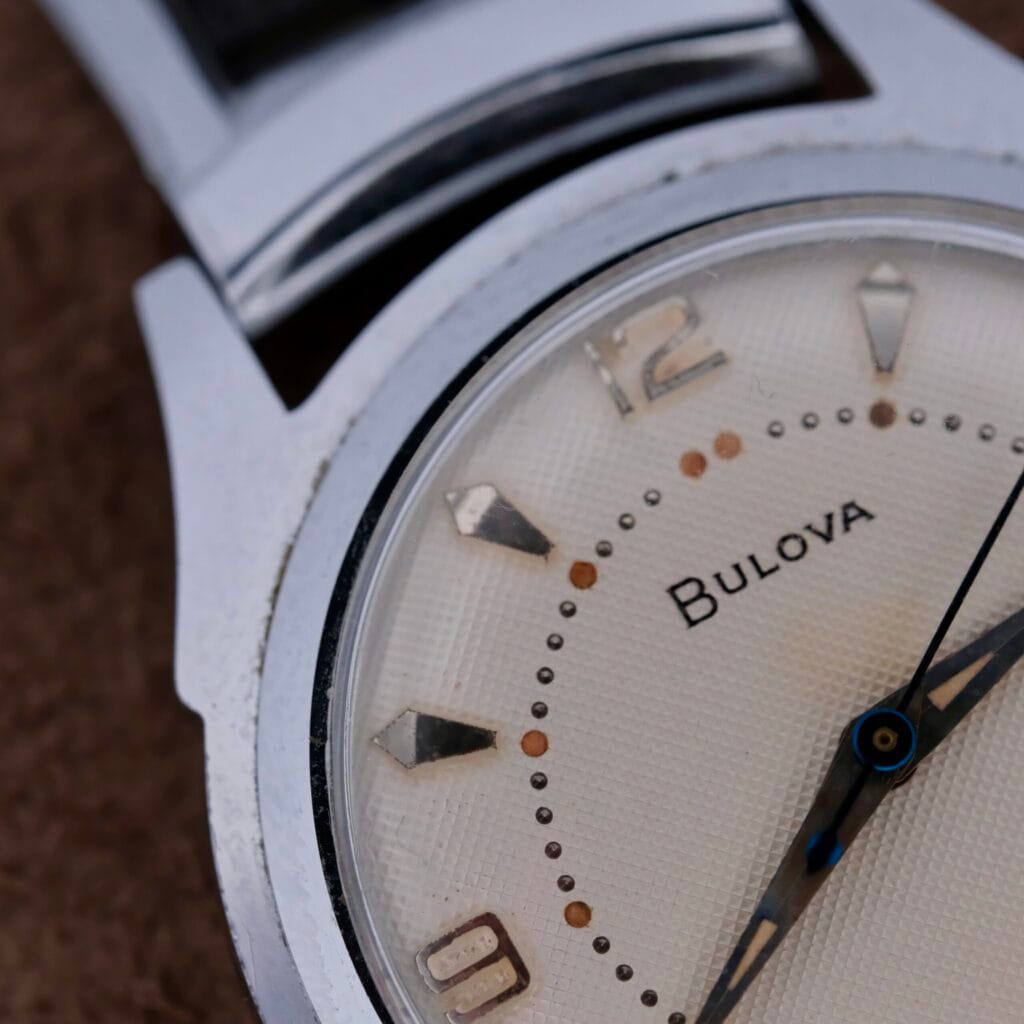Don't miss the next drop
The Rolex Datejust revolutionized wristwatches in 1945 as the world’s first self-winding waterproof chronometer with an automatically changing date, establishing design principles that endure today. This comprehensive guide traces its evolution through 1990, with detailed focus on collector-favorite references 1601, 1603, 16013, and 16233—watches that represent the pinnacle of mid-century to modern vintage Rolex craftsmanship and currently offer exceptional value in the pre-owned market.
Birth of an icon: The revolutionary 1945 debut
Rolex launched the Datejust in 1945 to commemorate the company’s 40th anniversary, introducing reference 4467 exclusively in 18-karat yellow gold. The revolutionary watch combined three major Rolex innovations into one timepiece: the Oyster case (waterproof since 1926), the Perpetual rotor (automatic winding from 1931), and chronometer precision. Most significantly, it featured the world’s first automatically changing date window at 3 o’clock—a complication that would become industry standard.
The original ref. 4467 housed Caliber 710, which necessitated a dramatically domed “Bubbleback” case design. Rolex also introduced the five-piece Jubilee bracelet specifically for this anniversary model, creating what would become one of watchmaking’s most recognizable bracelet designs. The original featured applied gold dagger indices, alpha hands with radium inserts, and initially lacked the “Datejust” name on the dial, showing only “Chronometre.” While initially conceived as a limited edition of 100 pieces, the watch’s instant success led to continuous production.

President Dwight D. Eisenhower’s yellow gold Datejust ref. 6305, received in 1951 as NATO Supreme Commander, appeared on Life Magazine’s cover in July 1952 and established the model’s association with world leaders. This single watch, Rolex’s 150,000th officially certified chronometer, wore throughout both presidential terms and cemented the Datejust as a symbol of achievement.
The 1950s: Cyclops innovation and refined aesthetics
The decade brought transformative developments. In 1954, Rolex introduced the Cyclops magnifying lens over the date window—a 2.5x magnification feature patented in 1955 that became one of horology’s most copied elements. References 6304 and 6305 first offered this innovation, though initially as an option rather than standard equipment. By 1955, Rolex perfected the instantaneous date change mechanism, ensuring the date clicked over precisely at midnight.
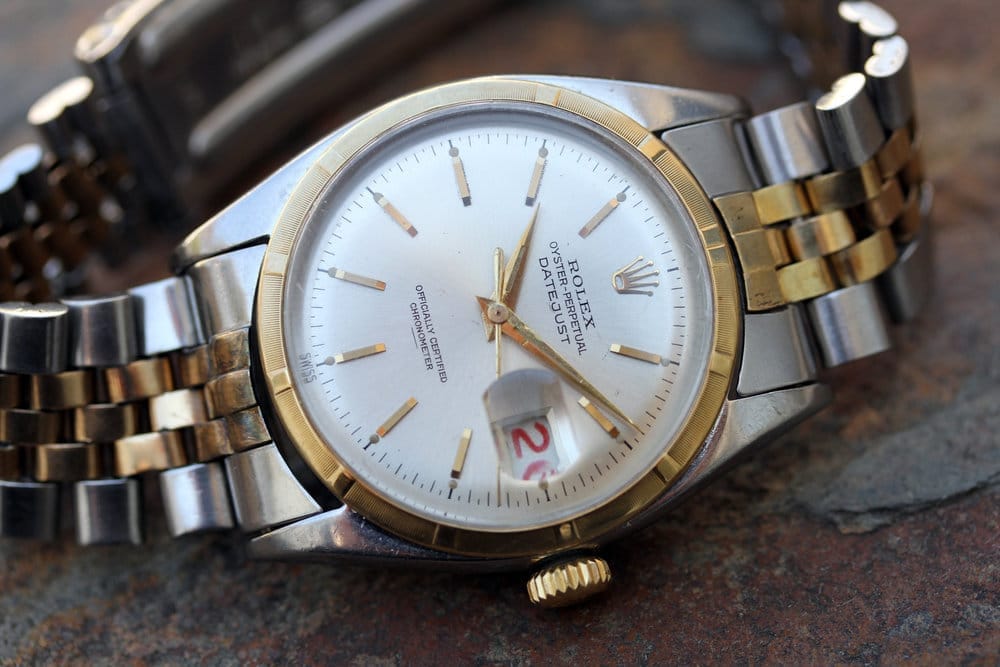
Movement evolution proved equally significant. Around 1957, Caliber 1065 replaced the earlier 710, eliminating the need for the Bubbleback case design and creating the slimmer, more contemporary profile that would define the modern Datejust. This same year saw the introduction of the Lady-Datejust at 26mm, expanding the collection’s appeal. The fluted bezel, manufactured in white gold on steel models from the late 1950s onward, established the iconic aesthetic contrast that makes vintage Datejust watches instantly recognizable.
The Turn-O-Graph variant, introduced in 1954 as ref. 6309, featured a rotating timing bezel and earned the “Thunderbird” nickname through its association with the U.S. Air Force Thunderbird Squadron. This variant represented Rolex’s experimentation with tool watch elements within the dressy Datejust framework.
The 1960s-1970s: The archetypal vintage Datejust emerges
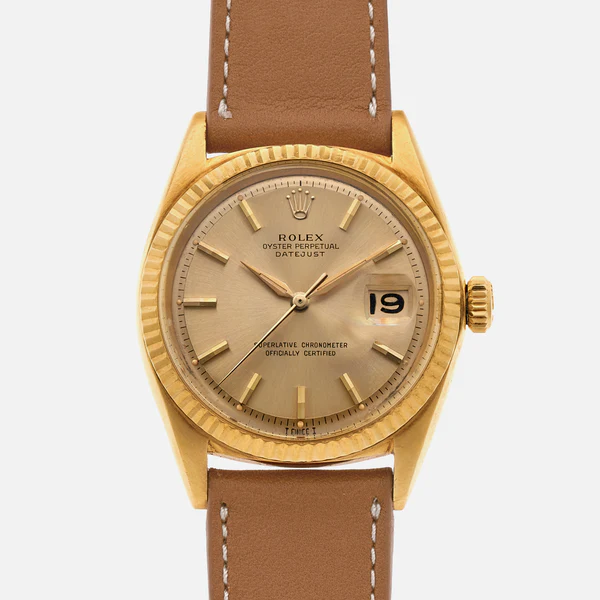
Reference 1601 (1960-1981): The quintessential classic
Reference 1601 stands as the archetypal vintage Datejust, produced for over 20 years with minimal design changes. This longevity allowed the watch to establish the template for all future Datejust models. The 36mm case in stainless steel featured a fluted bezel in 18-karat white gold, creating an elegant contrast that provided luxury without ostentation. The watch measured 11.7-12mm thick with 44mm lug-to-lug spacing and 20mm lug width, proportions that remain ideal for modern wrists.
Movement evolution within the 1601’s production run documented Rolex’s technical advancement. Early examples housed Caliber 1565 (1960-1965), running at 18,000 vibrations per hour with 42-hour power reserve. From 1965 onward, Rolex upgraded to Caliber 1575, increasing the beat rate to 19,800 vph for enhanced accuracy. A significant milestone arrived in 1972 when Rolex added hacking seconds functionality, allowing the seconds hand to stop when the crown was pulled for precise time setting. Both movements featured 26 jewels, instantaneous date change at midnight via cam-and-jewel system, and bidirectional self-winding with the Microstella regulating system.
Case materials ranged from stainless steel with white gold fluted bezel (the most common and collectible configuration) to two-tone steel and yellow gold variants, rare solid gold versions in yellow, rose, or white gold. The steel case utilized 316L stainless steel—this preceded Rolex’s later adoption of 904L—with drilled lug holes for easy strap changes, a vintage characteristic that disappeared from later references.
Dial variations make the 1601 endlessly fascinating for collectors. Beyond standard silver sunburst, champagne, black, and blue dials, the reference offered extraordinary exotic options. Pie-pan dials with their characteristic stepped outer edge dominated early production, creating depth and visual interest. Linen-textured dials with woven-like patterns command substantial premiums today, particularly when combined with sigma dials—those marked with small σ symbols flanking “T SWISS T” at 6 o’clock, indicating 18-karat white gold hour markers and hands (produced circa 1970-1973).
Tropical dials represent naturally aged examples where UV exposure transformed black dials to warm chocolate brown with golden undertones, creating unique patinated pieces. Stone dials in lapis lazuli, red jasper, malachite, and tiger’s eye (typically reserved for solid gold cases) represent the rarest and most valuable variations, with examples selling for $20,000-$60,000 depending on condition. The “Buckley dial” featuring large painted Roman numerals paired with painted hands offers distinctive period character, while “Wide Boy” variants featured extra-thick baton markers with matching wide hands.
Current market positioning makes the 1601 accessible yet appreciating. Stainless steel examples in good condition trade for $5,000-$6,500, with excellent examples reaching $6,500-$8,500. Two-tone variants command $5,500-$7,000 in good condition, while solid gold versions start at $10,000 and exceed $20,000 for exceptional examples. Special dials command significant premiums: linen dials add 30-50%, sigma dials 20-40%, tropical dials 40-70%, and stone dials 150-200% or more. Long-term appreciation proves compelling, with the reference gaining 238% from 2010 to 2025, stabilizing around $8,956 average after the 2022 market correction.
Reference 1603 (1960-1978): Steel sophistication
The 1603 shared the 1601’s case, movement, and dimensions but distinguished itself through an engine-turned steel bezel instead of the fluted gold bezel. This all-steel construction created a more understated, tool-watch aesthetic while maintaining the same 36mm proportions and Oyster case architecture. Produced from approximately 1960 to 1978, the 1603 represents exceptional value for collectors seeking vintage Datejust character without precious metal pricing.
Movement specifications mirrored the 1601 exactly: early production featured Caliber 1565 (1960-1965), transitioning to Caliber 1575 from 1965 onward, with hacking seconds added in 1972. The identical 26-jewel movements provided the same reliability and 19,800 vph accuracy as their gold-bezeled sibling.
The engine-turned bezel defines the reference. Early 1960s examples featured the highly collectible “bamboo” bezel with segmented, stalk-like appearance, revised to a different grooved pattern by the mid-1960s. This decorative milled steel bezel caught light beautifully while maintaining the watch’s all-steel integrity—a design element Rolex discontinued in the mid-2000s, making these vintage examples increasingly desirable.
Dial options matched those available on the 1601, though certain variations proved more common on the all-steel model. Silver sunburst, white, black, slate grey, and champagne served as standard options. Gray linen sigma dials on the 1603 command particular collector interest, representing rarer configurations than the more common silver linen. Blue tropical dials aged to warm patinated tones prove highly sought-after, while the “Buckley” dial with painted Roman numerals appeared more frequently on the 1603 than other variants, fitting its sporting character.
Rolex Datejust 1603 Silver Dial Alpha hands
$3,250.00
This 1960s Rolex Datejust 1603 features a stainless steel Oyster case topped with a crisp, unpolished engine-turned bezel. The all-original Rolex dial is distinguished by its wide hour markers and original Alpha hands. While the case shows honest signs of its age, the bezel remains exceptionally sharp. Powering the watch is the reliable Rolex Caliber 1560 automatic movement. This classic timepiece is paired with a handsome dark brown Horween leather strap.
Market analysis reveals the 1603 as 2025’s strongest vintage Datejust performer. Five-year appreciation of 26.5%outpaces all other references discussed, with past-year growth of 5% demonstrating continued momentum. Current pricing ranges from $4,000-$4,800 for fair condition examples to $6,500-$8,500 for excellent specimens—representing 15-20% less than comparable 1601 models despite identical movements and dimensions. Special dial variations command appropriate premiums: gray linen sigma dials reach $8,000-$11,000, blue tropical dials $8,500-$12,000, and gilt black dials $7,500-$10,000. This value proposition makes the 1603 the smartest investment among vintage Datejust references for knowledgeable collectors.
The 1970s-1980s: Technical revolution and modern transformation
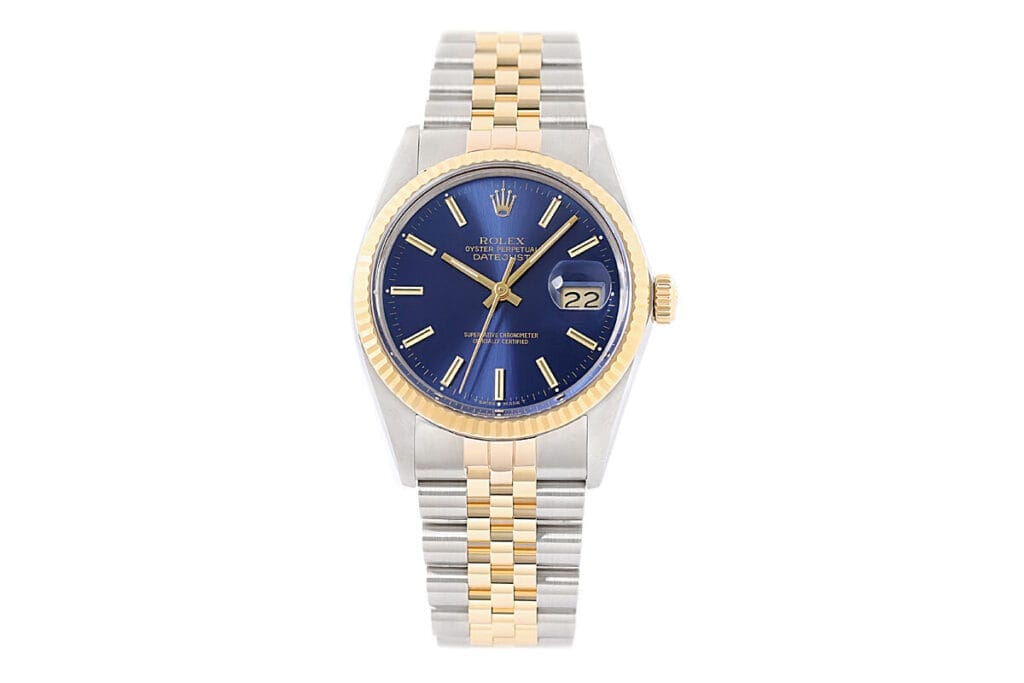
Reference 16013 (1977-1988): The quickset pioneer
Reference 16013 marked a watershed moment in Datejust evolution, introducing Caliber 3035—Rolex’s first high-beat movement and first automatic caliber with quickset date functionality. This two-tone steel and gold reference bridged vintage aesthetics with modern convenience, becoming an icon of 1980s luxury.
Caliber 3035 represented genuine innovation. Operating at 28,800 vibrations per hour (4 Hz)—dramatically higher than the previous 19,800 vph—the movement provided noticeably smoother seconds hand sweep and improved accuracy. The 27-jewel movement featured 42-50 hour power reserve with a fast-rotating barrel. Most significantly, the quickset date function allowed independent date adjustment without moving the hour and minute hands, accomplished through counter-clockwise crown rotation with 1.5 turns per date advance. The movement included hacking seconds, bidirectional rotor, Microstella regulating system, and Breguet overcoil hairspring, though notably it was not COSC certified (unlike its successor, the 3135).
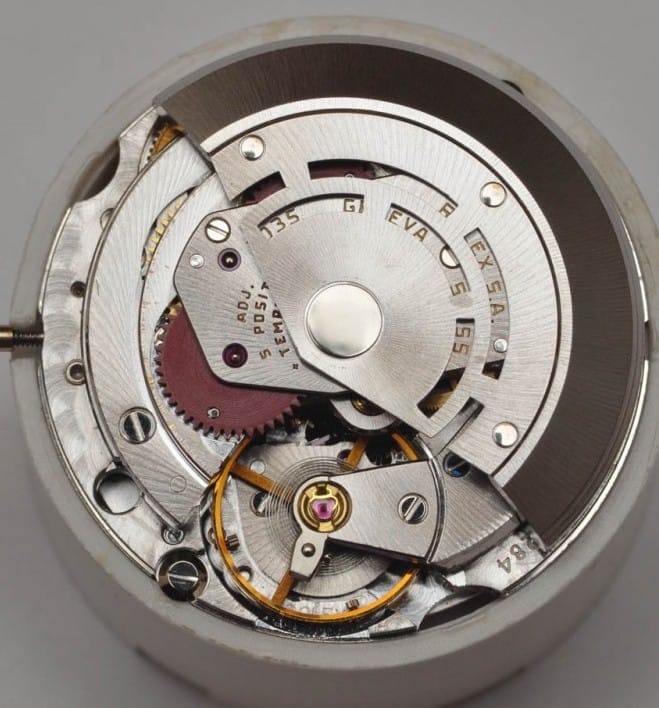
The 36mm case maintained classic Datejust dimensions while introducing modern elements. Early production retained acrylic crystal with Cyclops magnifier, though sapphire crystal gradually phased in during the mid-to-late 1980s. The two-tone “Yellow Rolesor” construction combined stainless steel case with 14-karat or 18-karat yellow gold fluted bezel—earlier models often used 14k gold, transitioning to 18k in later 1980s production. Drilled lug holes remained throughout the reference’s production, a vintage characteristic that would disappear on subsequent models.
Bracelet options included the five-piece Jubilee bracelet (most common) and three-piece Oyster bracelet, both featuring hollow center links in 14k or 18k gold with stainless steel outer links. This hollow construction provided comfort and flexibility but proved prone to stretch over decades of wear—significantly affecting value in today’s market.
Dial varieties emphasized the two-tone aesthetic. Champagne dials became the most iconic pairing with the gold bezel, creating the quintessential 1980s luxury watch appearance. Silver, black, white, and particularly desirable blue sunburst dials provided alternatives. Exotic options included tapestry-textured dials with fabric-like patterns, linen texture, engine-turned decorative patterns, and rare stone dials in mother-of-pearl, malachite, and lapis lazuli. Diamond hour markers (factory or special order), Roman numerals, and Arabic numerals expanded customization options. The dial used tritium luminescence, marked “T SWISS T” or “Swiss T<25” at the bottom.
Production spanned 1977 to 1988, with serial numbers progressing from 5,4XX,XXX series through sequential numerics until mid-1987’s introduction of the letter prefix system beginning with “R” series. Final production featured R-series and early L-series serials (1988-1989).
Market positioning shows the 16013 as currently underperforming, creating potential opportunity. Fair condition examples sell for $4,000-$4,500, good condition $4,500-$5,800, and excellent condition $5,800-$7,500. Special dial variations command premiums: factory diamond dials add 25-35% ($6,500-$8,500), blue dials 15-25%, tapestry dials 20-30%, and rare Tiffany & Co. co-signed dials 80-120% ($10,000-$15,000). Long-term appreciation remains strong at 205% since 2011, though five-year performance shows slight decline (-1.5%) and past-year weakness (-2%). This temporary softness may represent value opportunity, particularly as the two-tone aesthetic experiences renewed collector interest.
Reference 16233 (1988-2005): Modern reliability meets vintage charm
The 16233 evolved directly from the 16013, introducing the legendary Caliber 3135—arguably the most successful automatic movement in watchmaking history—along with scratch-resistant sapphire crystal as standard equipment. Produced from 1988 to approximately 2005, this reference achieved the highest sales volumes of any Datejust variant, establishing itself as the “quintessential two-tone Rolex.”
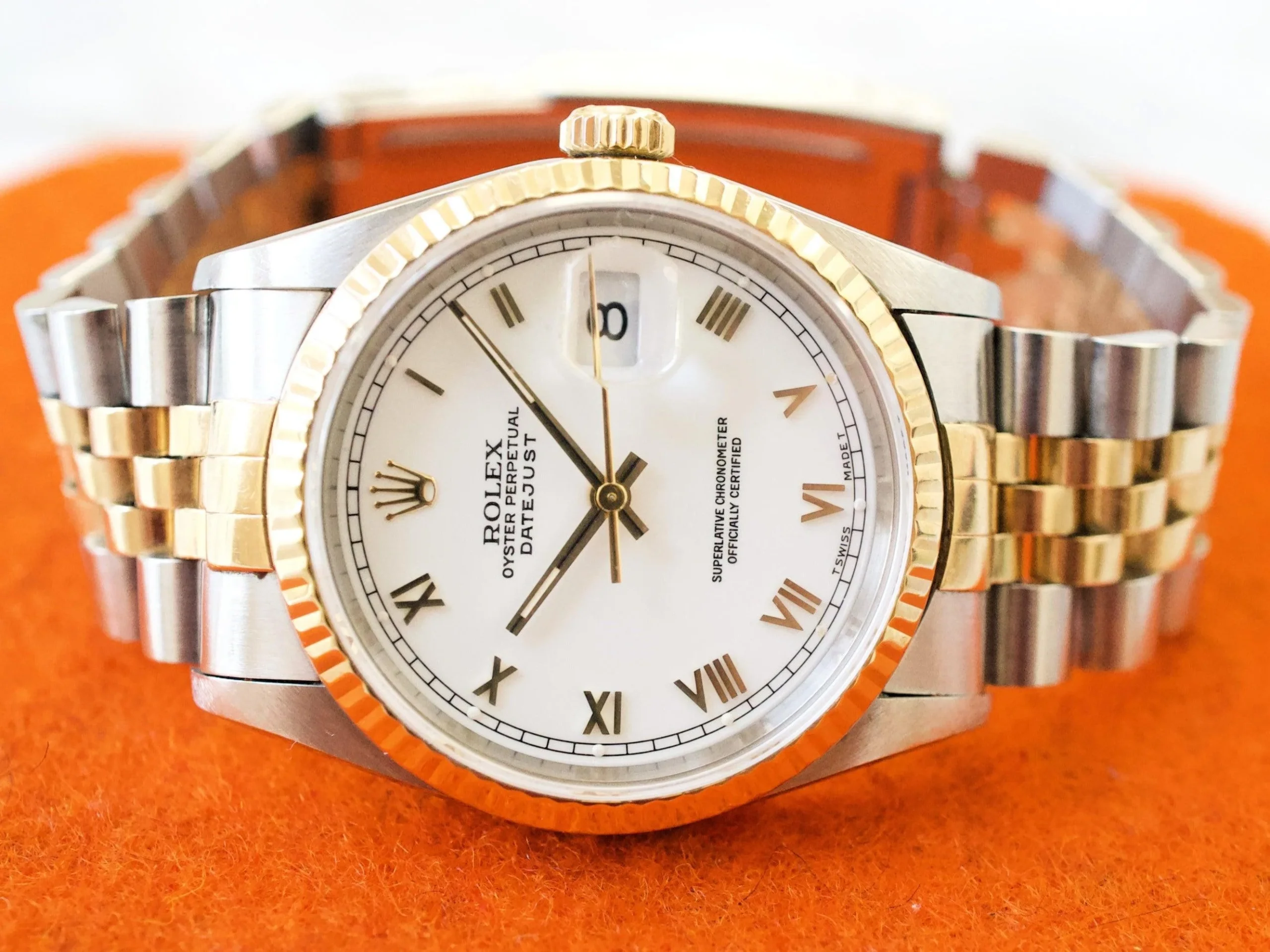
Caliber 3135 represented substantial advancement over the 3035. The 31-jewel movement (up from 27) operated at 28,800 vph with improved 48-hour power reserve. Structural improvements included a full balance bridge replacing the balance cock design, larger balance wheel for increased stability, and the addition of Paraflex shock absorbers. The quickset date mechanism improved to 3 dates per full crown rotation versus 1.5 in the 3035, with direction changed to clockwise rotation. From 2000 onward, Rolex introduced the revolutionary Parachrom Bleu hairspring made from niobium, zirconium, and oxygen—providing 10 times greater shock resistance and antimagnetic properties. Critically, the 3135 achieved COSC Superlative Chronometer certification, a designation the 3035 lacked.
The case refinement maintained 36mm × 12mm dimensions while introducing quality improvements. All gold components used 18-karat yellow gold exclusively—more consistent than the 14k/18k mix in the 16013. Manufacturing advances created crisper lines and improved polishing. Drilled lug holes remained on early production (1988-mid-1990s) before being phased out, marking the transition to modern Rolex aesthetics. The most significant upgrade came with sapphire crystal as standard from production start, providing scratch-resistance that acrylic simply couldn’t match.
Bracelet construction paralleled the 16013 with five-piece Jubilee (most common) or three-piece Oyster options, featuring hollow 18k gold center links and stainless steel outer links. Later production introduced solid end links for improved durability, while the folding Crownclasp provided concealed elegance.
Dial options expanded on the 16013’s variety. Champagne remained the most popular choice, with white, silver, black, blue, navy, grey, and gold as standard colors. Special finishes included tapestry texture with woven patterns, linen texture, Jubilee pattern with special texture, radial sunburst brushing, computer/matrix grid pattern, and pyramid geometric pattern. Exotic materials encompassed mother-of-pearl in various colors and factory-set diamond hour markers. Luminescence evolved throughout production: tritium (1988-1998, marked “T SWISS T”), Luminova (1998-2000, marked “SWISS”), and Super-LumiNova (2000-2005, marked “SWISS MADE”).

Serial number progression documented the extended production run through letter prefixes: R (1987-1988), L (1989-1990), E (1990-1991), X/N (1991), C (1992), S (1993-1994), W (1995), T (1996), U (1997-1998), A (1998-1999), P (1999-2000), K (2000-2001), Y (2001-2002), F (2003-2005), and D (2005-2006). From 2005 onward, Rolex added laser-engraved serial numbers on the rehaut (inner bezel ring) in addition to the traditional location between the lugs.
Market strength for the 16233 derives from its position as the most popular two-tone Datejust historically. Current pricing ranges $5,000-$5,500 for fair condition, $5,500-$6,500 for good condition, and $6,500-$8,000 for excellent examples, with near-mint unworn pieces reaching $7,500-$9,000. Special dials command premiums: blue sunburst adds 10-15% ($6,800-$8,500), factory diamond dials 20-30% ($7,500-$9,500), and Jubilee Anniversary dials 20-30%. Five-year appreciation of 19.9% combined with past-year stability (+0.7%) demonstrates predictable performance. With 454 recorded sales in September 2025 alone, the 16233 offers exceptional liquidity—critical for both collectors and investors. The reference represents vintage aesthetics with modern reliability, making it ideal for daily wear.
Collecting vintage Datejust: Authentication and investment strategy
Authentication fundamentals
Authenticating vintage Datejust watches requires attention to multiple verification points. Movement inspection proves critical: the 1601 and 1603 should house Caliber 1565 (pre-1965) or 1575 (1965+), the 16013 Caliber 3035, and the 16233 Caliber 3135. Bridge markings, serial numbers, and finishing quality provide immediate authenticity indicators. Case verification involves checking serial numbers between lugs at 6 o’clock and reference numbers at 12 o’clock, confirming correct case dimensions (36mm diameter, 11.7-12mm thickness), and examining appropriate case finishing with brushed sides and polished lugs.
Dial authenticity requires careful scrutiny. Period-correct tritium markings (“SWISS” or “T SWISS T” or “Swiss <25”) must appear at the bottom, with sigma dials displaying “σ T SWISS T σ” on 1970s examples. Font style, spacing, printing quality, and intact lume plots matching the hands all signal originality. Moisture spots, spider-webbing, or refinishing attempts devastate value—refinished dials reduce worth by 40-60%.
Bezel verification matters enormously. The 1601 should feature fluted gold bezels in white, yellow, or rose gold; the 1603 its distinctive engine-turned steel; and the 16013/16233 fluted 18k gold. Crystal type must match the era: acrylic with Cyclops on 1601/1603, transitional acrylic or sapphire on 16013, and sapphire on all 16233 examples. Bracelet authentication involves verifying correct reference numbers inside the clasp, matching end link numbers, and appropriate construction for the era (folded links on vintage, hollow center links throughout).
Red flags and value detractors
Several issues destroy value significantly. Refinished or service dials represent the most common problem, reducing value 40-60% even if professionally executed—collectors prize original patina over pristine condition. Incorrect replacement hands cost 20-30% of value. Heavy polishing that removes metal and rounds case edges reduces value 30-40%, with completely missing serial numbers (over-polished) costing 40-50%. Water damage proves nearly catastrophic, reducing value 50-70% or rendering pieces worthless. Frankenstein watches assembled from mixed-reference parts lose 60-80% of value.
Bracelet condition dramatically affects pricing. Minimal stretch commands standard pricing, while slight stretch (1-2cm extension) costs 10-15%, moderate stretch (2-3cm) reduces value 20-25%, and heavy stretch (3+cm) decreases worth 30-40%. Missing original bracelets reduce value 15-25%, though quality leather straps provide elegant alternatives.
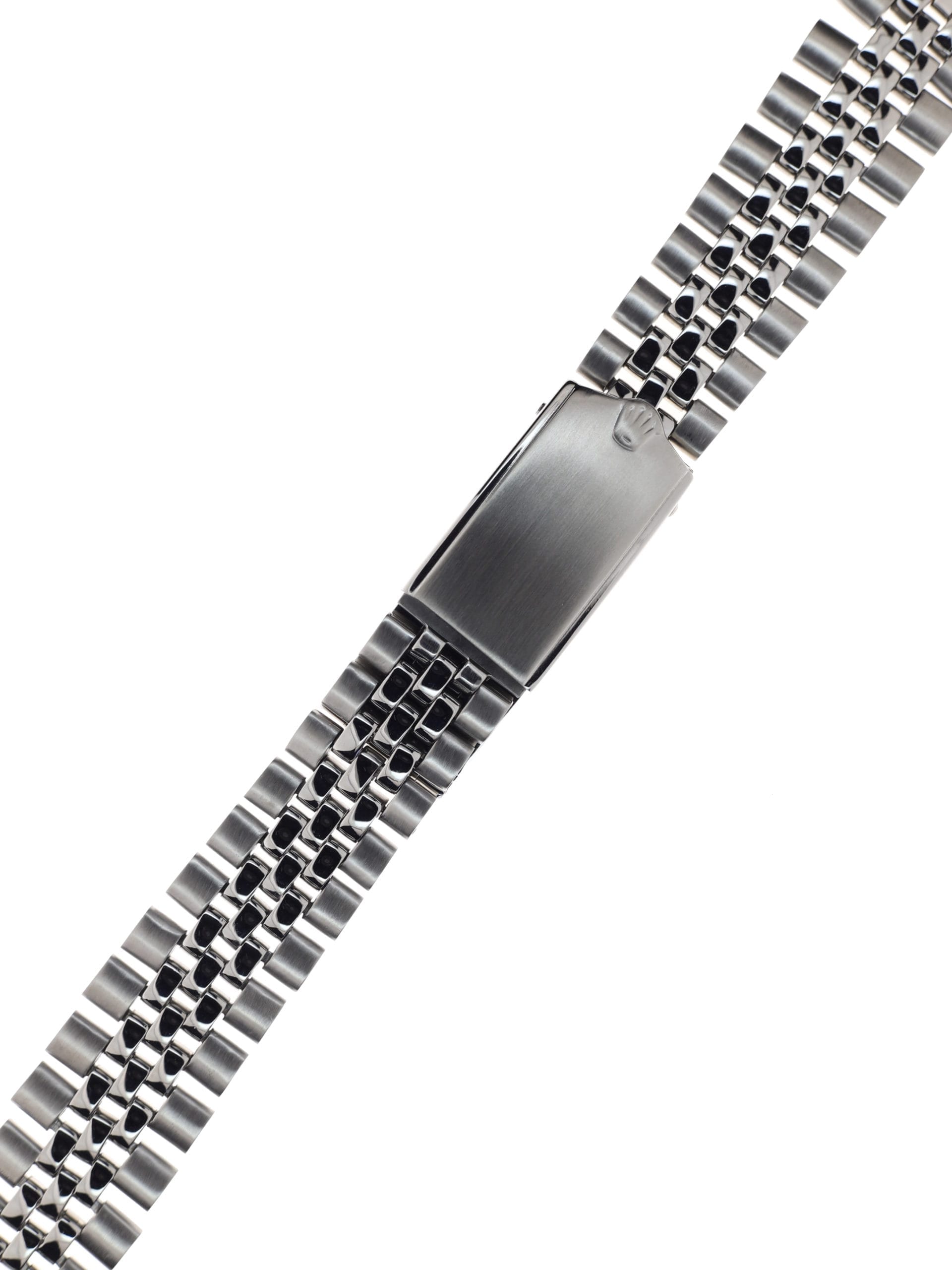
Investment strategy by budget
Under $5,000: Target the 1603 steel with standard dial in good condition as the best value proposition, or consider a 16013 two-tone in fair condition. Avoid over-polished examples and questionable authenticity at this price point.
$5,000-$7,000: The 1601 steel with standard dial in excellent condition represents the classic choice, while the 1603 with blue dial or early production offers investment upside. The 16233 champagne dial in good condition provides modern reliability for daily wear.
$7,000-$10,000: Pursue the 1601 with linen or sigma dial for collector appeal, the 16233 diamond dial in excellent condition for modern luxury, or the investment-grade 1603 with rare gray linen sigma dial currently undervalued.
$10,000-$15,000: Focus on 1601 linen sigma dial full sets (box, papers, tags) in unpolished condition, 1601 tropical dials with strong patina, or rare two-tone 1601 variants with special dials.
$15,000+: Target 1601 solid gold with stone dials (lapis, malachite, red jasper), pieces with exceptional provenance and documentation, or rare retailer-signed dials from Tiffany & Co., Serpico y Laino, or Asprey.
Comparative value analysis
The 1603 offers best overall value in 2025, combining the same case and movement as the 1601 at 15-20% lower pricing due to its steel bezel. Five-year appreciation of 26.5% outperforms all references, with understated elegance appealing to knowledgeable collectors. The 1601 represents the classic investment, featuring the iconic fluted gold bezel, widest dial variety, proven 238% appreciation since 2010, and strong market recognition. The 16233 provides modern reliabilitywith the legendary Caliber 3135, sapphire crystal, highest liquidity (454 monthly sales), and lowest maintenance requirements. The 16013 presents a transitional bargain, currently underperforming at -2% annually but offering quickset date and modern features at 15% discount to the 16233.
Material recommendations depend on goals. For pure investment, pursue stainless steel 1601/1603 with rare dials (linen, sigma, tropical), solid gold 1601 with stone dials (highest appreciation potential), or steel 1603 (best current value). For wearability, choose two-tone 16233 (versatile, reliable), steel 1601 with standard dial (serviceable classic), or two-tone 16013 (value with modern features). For collecting, target 1601 with special dials (widest variety, highest premiums), early 1960s 1603 with pie-pan dial and gilt features, or 16233 champagne dial full sets (iconic modern vintage).
Notable wearers and cultural significance
Beyond President Eisenhower’s famous ref. 6305, the Datejust adorned influential figures throughout the 20th century. Winston Churchill received Rolex’s 100,000th certified chronometer (a 1948 Datejust), while President Ronald Reagan wore a steel Datejust with Jubilee bracelet throughout his presidency. Civil rights leader Martin Luther King Jr., actor Paul Newman in “The Color of Money,” and Harrison Ford in “Frantic” (1988) each chose Datejust models, cementing the watch’s status beyond mere luxury object to cultural icon.
The two-tone Datejust, particularly the 16013, became synonymous with 1980s Wall Street success—a symbol of achievement for rising executives that represented aspiration without the flashiness of the all-gold Day-Date. This association gained literary immortality in “American Psycho,” where Patrick Bateman’s two-tone Datejust epitomized the era’s material obsessions. The watch occupied a perfect middle ground: neither sporty like the Submariner nor ostentatious like the Day-Date, making it appropriate for any occasion.
Technical evolution and modern legacy
The journey from 1945’s ref. 4467 to 1990’s ref. 16233 documents watchmaking evolution through incremental perfection rather than revolutionary redesign. The original Caliber 710’s 18,000 vph and 40-hour power reserve gave way to the 1575’s 19,800 vph and 42-hour reserve, then the 3035’s groundbreaking 28,800 vph with quickset date, culminating in the 3135’s 48-hour power reserve, COSC certification, and Parachrom hairspring. This movement progression established standards still governing Rolex’s current production—the 3135 remains in service decades later, with modern calibers like the 3235 building directly on its architecture.
Design evolution proved equally methodical. The 1954 Cyclops lens, 1957’s elimination of the Bubbleback case, 1972’s hacking seconds, 1977’s quickset date, and 1988’s sapphire crystal each represented calculated improvements to a fundamentally perfect design. By 1990, the Datejust had achieved its final form: 36mm remained the classic size (joined by 26mm Lady-Datejust and 31mm mid-size), sapphire crystals became universal, drilled lugs disappeared for cleaner aesthetics, and Super-LumiNova replaced tritium for safety and longevity.
The four references examined here document this transformation. The 1601 and 1603 (1960-1981/1978) represent peak vintage aesthetics with pie-pan dials, acrylic crystals, and movements achieving chronometer precision through mechanical artistry alone. The 16013 (1977-1988) bridged eras, introducing high-beat movements and quickset convenience while maintaining vintage proportions and acrylic crystals. The 16233 (1988-2005) completed the modernization with sapphire crystals, COSC certification, and advanced materials while preserving the essential character that makes a Datejust recognizable across seven decades.

Investment outlook and market trends
The vintage Datejust market in 2025 has stabilized following the dramatic 2020-2022 pandemic boom and subsequent 2022-2023 correction. After peaking at $17,206 average in March 2022, the broader Datejust market corrected 31% to $11,785 before stabilizing at $13,426 by June 2025—still representing 550% growth since 2010. This correction eliminated speculative froth while maintaining strong fundamentals driven by fixed supply, brand strength, and renewed interest in 36mm sizing.
Reference-specific trends reveal opportunities. The 1603’s +26.5% five-year performance and +5% past-year growth mark it as the strongest performer, with the market finally recognizing its undervaluation relative to the 1601. The 1601’s stability (+1.7% past year) after 238% long-term appreciation demonstrates mature, predictable pricing. The 16233’s flat performance (+0.7%) combined with exceptional liquidity makes it the safest choice for conservative collectors. The 16013’s -2% past-year decline may represent temporary weakness in an otherwise solid reference bridging vintage and modern characteristics.
Dial premiums continue expanding, with special variations commanding 30-100% over standard examples. Stone dials (lapis, malachite, red jasper) lead at 150-200% premiums ($20,000-$60,000), followed by tropical dials (40-70%), linen dials (30-50%), and sigma dials (20-40%). This premium expansion reflects collector sophistication—knowledgeable buyers recognize rarity and pay accordingly. Standard silver, champagne, and black dials maintain stable pricing but lack appreciation upside.
Condition sensitivity has intensified. Unpolished examples with original dials, intact lume, sharp case edges, and minimal bracelet stretch command 30-50% premiums over good condition pieces. Refinished dials, heavy polishing, and water damage prove nearly unsaleable. This trend toward originality over cosmetic perfection mirrors broader vintage watch market maturation.
2025-2027 outlook suggests stable 3-5% annual appreciation for quality pieces with desirable features, while common examples stay flat. Special dials will continue outperforming, the 1603 should catch up to 1601 valuations, and economic conditions will drive short-term volatility. The fundamental case remains strong: discontinued references with fixed supply, growing collector base (millennials/Gen Z entering market), versatile 36mm sizing appealing to all genders, and relative affordability versus sports models (Submariner, GMT).
Conclusion: Timeless design, enduring value
The Rolex Datejust from 1945 to 1990 represents one of watchmaking’s most successful designs, combining revolutionary functionality with timeless aesthetics. The four references examined—1601, 1603, 16013, and 16233—capture this evolution at critical junctures, each offering distinct appeal for today’s collectors. The 1601’s fluted gold bezel and diverse dial options provide classic vintage character with proven appreciation. The 1603’s all-steel sophistication and engine-turned bezel deliver understated elegance and strongest current growth. The 16013’s quickset date and transitional character offer modern convenience in vintage proportions at value pricing. The 16233’s Caliber 3135 and sapphire crystal provide modern reliability with vintage aesthetics and exceptional liquidity.
For collectors entering vintage Rolex, these Datejust references offer accessible pricing ($4,000-$15,000 for most configurations), proven reliability, available service parts, and appreciation potential. For investors, they represent tangible assets with 70-year track records, fixed supply, and strong brand recognition. For enthusiasts, they deliver daily-wearable luxury with historical significance and design excellence. Whether pursuing a $6,500 steel 1603 as an entry piece or a $30,000 stone dial 1601 as an investment, the vintage Datejust rewards knowledge, patience, and appreciation for watchmaking’s most enduring icon.
Related posts
The Evolution of the Rolex Datejust: 1945-1990
The Rolex Datejust revolutionized wristwatches in 1945 as the world's first self-winding waterproof chronometer with an automatically c...
The Ultimate Guide to Vintage Omega Seamasters
Vintage Omega Seamasters represent one of the most compelling propositions in watch collecting today - offering military provenanc...
The Expert’s Guide to Rolex Serial Numbers and Reference Numbers
Understanding Rolex serial numbers is essential for any Rolex enthusiast, collector, or potential buyer. These unique identif...
The Collector’s Guide to Vintage Wittnauer Chronographs
Vintage Wittnauer chronographs represent one of the most compelling value propositions in the world of mid-century timepieces. While br...
Wittnauer Pert-o-Graph Ref. 7005: An Analog Computer for the Project Manager’s Wrist
Wittnauer Pert-o-graph, tool watch or something else? In the history of horology, the "tool watch" has traditionally been defined by it...
The Expert’s Guide to Buying Vintage Watches on eBay In 2025
eBay, to the aspiring watch collector, is a landscape of profound contradiction. It is a digital bazaar of immense scale, a place where...
Complete Guide to the Rolex Datejust 1601
In the grand pantheon of horology, few timepieces command the same blend of understated elegance, historical significance, and everyday...
How the Quartz Crisis Nearly Ended Swiss Watchmaking
Before the quartz crisis (1970s), the Swiss watchmaking industry stood as an unshakeable colossus, a global symbol of precision, intric...
An Expert’s Guide to Omega Reference Numbers
Omega's rich horological history, stretching back to 1848, has produced an astonishingly diverse and extensive catalogue of timepieces....
Patina vs. Damage on a Watch Dial
Among vintage watch enthusiasts and collectors, one of the most debated topics revolves around patina and damage. What sets the two apa...
How Old Is My Bulova Watch? Production Date Guide
Bulova, one of the first companies to mass-produce wristwatches in the early 20th century, has made it easier than most to identify the...
Transform Your Watch in Minutes: A Guide to Watch Straps
Your watch says as much about you as your outfit does. With a simple swap of a strap, you can transform a single watch into something f...
Recent Posts
Recent Comments
No comments to show.

